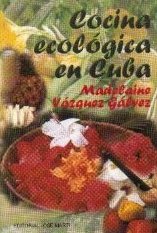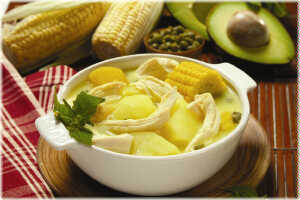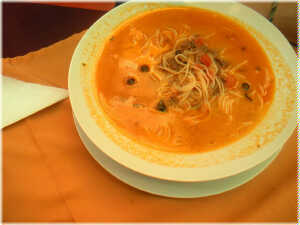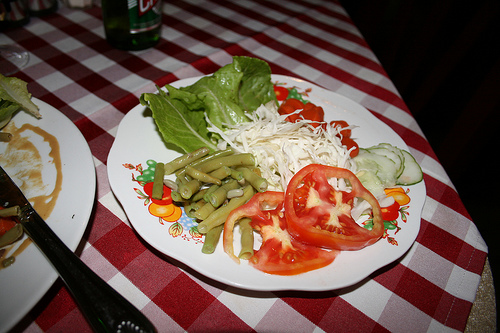Cuban Food Habit Challenges
By Lucia Lopez Coll

HAVANA TIMES, June 5 (IPS) – With no previous warning but with absolute discretion, Madelaine Vazquez Galvez has “entered” almost all Cuban homes. Her televised Saturday afternoon visits are anxiously awaited by those people (mainly women) who have the responsibility of cooking for their family, an often-undervalued task.
Madelaine’s recipes are an appetizing way to vary daily meals; starting with a better use of foods we’ve known all our lives and those that are readily available.
The inescapable need to cook with what is available on the island was one of the factors that compelled this engineer in social nutrition technology to continue the work begun by others on the TV program Con sabor (With flavor).
“I think traditional Cuban cooking can become more stylish and healthier, because we have aromatic plants and soil able to produce many more foods, which can contribute to creating a culture of knowing what to eat,” says this concerned woman. She has dedicated a great part of her life to sharing this indispensable knowledge for improving the Cuban diet.
“This does not mean that we have to scrap what is traditional, which unquestionably contains great wisdom, just like the cooking of all peoples. In our case, this is summed up in the consummate formula of beans and rice, whereby the amino acid spectrum is supplemented, though we need to diversify and incorporate other foods.
“Though it might seem paradoxical, in the preparation of the program Con sabor my sources come from traditional Cuban cuisine: from the books Do You Like… and those of Nitza Villapol. However, my final recipe is the result of stylization that integrates new flavors. Nevertheless, to get real acceptance of these recipes, it’s necessary to travel a long road, in company and with the support of other institutions and organizations, until reaching the desired objective. That’s not easy in Cuba, or any place else.”
Madelaine’s training began with five years of studies at the Institute of Soviet Trade in the Ukraine, and upon graduation she worked for twelve years as the principal specialist in the former Office of Social Nutrition and Gastronomy of the Cuban Ministry of Domestic Trade. It was here that technical guidelines governing the norms of nutrition for the general population were developed, including those for the country’s restaurants.
The Test Came in the Early 1990s

However, for Madelaine, the real story began in the early 1990s, when she decided to sign up for a project that was unprecedented for any cooking professional on the island. It was to create an ecological restaurant at the National Botanical Garden, though at a very difficult time given the major shortage of resources throughout the country.
“At the end of 1991, the Cuba-Mexico Workshop of Food Culture took place under the sponsorship of the Botanical Garden and the Autonomous National University of Mexico (UNAM).
“The director of the Botanical Garden was delighted with the salad table that we presented, so she proposed that we create a vegetarian restaurant. The aim was not to promote vegetarianism, but to encourage diets that included vegetables,” she recounted.
“A work team was formed that, on the basis of studies, was conscious that the human diet is a closed cycle involving everything from agriculture to eating habits. Likewise, we knew that the use of a wide variety of vegetables was still very new in Cuba and other countries.
“This was how the eco-restaurant ‘El Bambu’ (Bamboo) was born in 1992 near the park’s Japanese Garden. Here, I had to cook a great deal in order teach how to cook. What’s certain is that we studied and learned a lot during those years, and I obtained a greater knowledge of culinary technology, specifically that relating to vegetables.
“I was even somewhat interested in the precepts of oriental cooking, which has a different structure than western cooking. All this helped me to expand my cultural horizons, to understand the importance of variety in nutrition, which is exemplified in the use of aromatic plants in cooking – going beyond the garlic, onion, tomato and pepper seasonings so commonly used in Cuba.

“Among the goals of the project, the Botanical Garden contemplated taking advantage of its magnificent collections of tropical and subtropical flora from around the entire planet, a little known fact, and promoting organic orchards that did not use fertilizers. Nearly 70 percent of the needs of the restaurant, which served close to 200,000 people annually, were supplied by its own produce and fruit-bearing trees at the park.
“The menu was designed based on two fundamental principles: respecting the alimentary preferences of Cubans and keeping in mind the availability of resources, though we always added a different, original twist that would catch the customers’ attention.
“During the 1990s “Special Period” crisis, the eco-restaurant was one of the places that helped to fill the great needs of the time. However, what was more important was that it demonstrated a different pattern of eating. Although the capacity was for sixty people, we seated hundreds by working to find the space.
“Sometimes we used plants that are overlooked here, like cactuses called nopal and chaya. It felt like a school, because many people came to see what we were doing.

“Although I began cooking on charcoal and had to attend to the kitchen most of the time, without getting to meet the customers, we always tried to make the experience educational, giving diners information that contributed to changing their approach to what they ate. Formal discussions were held, informational approaches were created; we organized national and international workshops on nutrition with non-conventional approaches.
“We also produced 13 issues of the Boletin Germinal newsletter, which had information on dietary topics and several recipes. These were given to participants of gatherings held in the ecological court once a month. We had to stop putting out the Bulletin due to resource limitations, though we hope to restart it at some time.
“The Bamboo restaurant created a menu of about 20 dishes that included about 15 salads. There was also, ajiaco (a spicy potato dish), and root vegetables (yucca, sweet potatoes and white potatoes) with mojo (a Cuban seasoning), Moorish rice, congri (a beans and rice dish), several pastas, and egg and milk products. For dessert, one of the specialties was fruit ice cream and root vegetables, using the technology of the restaurant.”
Ecological Cooking in Cuba

All of this culinary experience was compiled by Madelaine and published in the cookbook Cocina ecológica en Cuba (Ecological Cooking in Cuba), which came out in three editions. Its general edition (32,000 copies) contributed to filling a void in Cuban cuisine in that its recipes revealed novel and healthy possibilities. Furthermore, it took advantage of Cuba’s vegetable variety for promoting nutritional ends while upholding sustainable approaches.
As part of that zeal to share her knowledge about such an essential subject, Madelaine now works in a program to instruct teachers in Alimentary Culture for the older adults, as the thesis of her Master’s of Science in Education.
“Our population is aging and it’s necessary to look for ways to change the habits of that older segment of the population, who though seem to be more reluctant to change, in fact are not, as long as these habits influence in their quality of life positively and they are made more risk-conscious,” the specialist asserted.
The opportunity to work on the Con sabor program expanded Madelaine’s reach as a professional, convinced of the necessity to introduce changes in the dietary habits of the Cuban people, although she is aware that this must be dome in an intelligent manner, without completely distorting a pattern “formed over our historical development.”

“Cuban cuisine is rich in terms of its food, but frying prevails as a cooking method. It does not employ sautéing or boiling to season food with aromatic plants. It is lavish in dessert recipes, which can be positive, but is also negative because these entail consuming large quantities of sugar. Moreover, our diet does not value eating enough vegetables, and it is more common to consume fruits in the form of sweets. I don’t think that agricultural monoculture helped us with achieving variety.
“When we looked at the format of the program, we thought there were many possibilities for enriching it, especially by making information known about the benefits of plants and the alternative styles of Cuban eating. We need to learn how to extend the spectrum of meals, because many taboos and much ignorance exist as to what should be a balanced diet.
“I don’t use products that are outside of the reach of most of us. Instead, I motivate people to introduce seldom-explored combinations, since cooking can become very repetitive. Recently I prepared some ñoquis (sweet potato meatballs) instead of the original made from white potatoes, and they were exquisite.
“The process of “transcultural” exchange in international cooking has now given everything a lot of alternatives, so making sweet potato ñoquis is a way to updating cooking; it is also using a food that was cultivated by our indigenous predecessors long ago. Likewise, sweet potatoes were affected very little by the hurricanes, so it is necessary to learn how to cook them in a manner other than boiling and frying.
What is paradoxical is that now the sweet potato is considered a prestigious food worldwide for the presence of beta-carotenes, their high anti-oxidant properties. However, here we use them mainly to feed pigs and dogs. This type of thinking is what we want and must help to break in the Cuban diet.”
Translation from Spanish by Havana Times






I thought that it was interesting when you said that Cuban restaurants use different kinds of vegetables that aren’t common. I have been trying to find ways to try new foods that I wouldn’t normally try but I haven’t been sure where to go to do this. I will be sure to go to a Cuban restaurant to experience a different culture and meals.
Madelaine Vazquez Galvez, photo:revistafuturo.info
HAVANA TIMES, June 5 (IPS) – With no previous warning but with
absolute discretion, Madelaine Vazquez Galvez has “entered” almost all
Cuban homes. Her televised Saturday afternoon visits are anxiously
awaited by those people (mainly women) who have the responsibility of
cooking for their family, an often-undervalued task.
Madelaine’s recipes are an appetizing way to vary daily meals;
starting with a better use of foods we’ve known all our lives and those
that are readily available.
The inescapable need to cook with what is available on the island was
one of the factors that compelled this engineer in social nutrition
technology to continue the work begun by others on the TV program Con savor (With flavor).
“I think traditional Cuban cooking can become more stylish and
healthier, because we have aromatic plants and soil able to produce many
more foods, which can contribute to creating a culture of knowing what
to eat,” says this concerned woman. She has dedicated a great part of
her life to sharing this indispensable knowledge for improving the Cuban
diet.
“This does not mean that we have to scrap what is traditional,
which unquestionably contains great wisdom, just like the cooking of all
peoples. In our case, this is summed up in the consummate formula of
beans and rice, whereby the amino acid spectrum is supplemented, though
we need to diversify and incorporate other foods.
“Though it might seem paradoxical, in the preparation of the
program Con sabor my sources come from traditional Cuban cuisine: from
the books Do You Like… and those of Nitza Villapol. However, my final
recipe is the result of stylization that integrates new flavors.
Nevertheless, to get real acceptance of these recipes, it’s necessary to
travel a long road, in company and with the support of other
institutions and organizations, until reaching the desired objective.
That’s not easy in Cuba, or any place else.”
Madelaine’s training began with five years of studies at the
Institute of Soviet Trade in the Ukraine, and upon graduation she worked
for twelve years as the principal specialist in the former Office of
Social Nutrition and Gastronomy of the Cuban Ministry of Domestic Trade.
It was here that technical guidelines governing the norms of nutrition
for the general population were developed, including those for the
country’s restaurants.
The Test Came in the Early 1990s
Ecological Cooking in Cuba
However, for Madelaine, the real story began in the early 1990s, when
she decided to sign up for a project that was unprecedented for any
cooking professional on the island. It was to create an ecological
restaurant at the National Botanical Garden, though at a very difficult
time given the major shortage of resources throughout the country.
“At the end of 1991, the Cuba-Mexico Workshop of Food Culture
took place under the sponsorship of the Botanical Garden and the
Autonomous National University of Mexico (UNAM).
“The director of the Botanical Garden was delighted with the
salad table that we presented, so she proposed that we create a
vegetarian restaurant. The aim was not to promote vegetarianism, but to
encourage diets that included vegetables,” she recounted.
“A work team was formed that, on the basis of studies, was
conscious that the human diet is a closed cycle involving everything
from agriculture to eating habits. Likewise, we knew that the use of a
wide variety of vegetables was still very new in Cuba and other
countries.
“This was how the eco-restaurant ‘El Bambu’ (Bamboo) was born in
1992 near the park’s Japanese Garden. Here, I had to cook a great deal
in order teach how to cook. What’s certain is that we studied and
learned a lot during those years, and I obtained a greater knowledge of
culinary technology, specifically that relating to vegetables.
“I was even somewhat interested in the precepts of oriental
cooking, which has a different structure than western cooking. All this
helped me to expand my cultural horizons, to understand the importance
of variety in nutrition, which is exemplified in the use of aromatic
plants in cooking – going beyond the garlic, onion, tomato and pepper
seasonings so commonly used in Cuba.
Vegetable Soup, photo: cubasolar.cu
“Among the goals of the project, the Botanical Garden contemplated
taking advantage of its magnificent collections of tropical and
subtropical flora from around the entire planet, a little known fact,
and promoting organic orchards that did not use fertilizers. Nearly 70
percent of the needs of the restaurant, which served close to 200,000
people annually, were supplied by its own produce and fruit-bearing
trees at the park.
“The menu was designed based on two fundamental principles:
respecting the alimentary preferences of Cubans and keeping in mind the
availability of resources, though we always added a different, original
twist that would catch the customers’ attention.
“During the 1990s “Special Period” crisis, the eco-restaurant was
one of the places that helped to fill the great needs of the time.
However, what was more important was that it demonstrated a different
pattern of eating. Although the capacity was for sixty people, we seated
hundreds by working to find the space.
“Sometimes we used plants that are overlooked here, like cactuses
called nopal and chaya. It felt like a school, because many people came
to see what we were doing.
Tamales (steam-cooked corn), photo:cubasolar.cu
“Although I began cooking on charcoal and had to attend to the
kitchen most of the time, without getting to meet the customers, we
always tried to make the experience educational, giving diners
information that contributed to changing their approach to what they
ate. Formal discussions were held, informational approaches were
created; we organized national and international workshops on nutrition
with non-conventional approaches.
“We also produced 13 issues of the Boletin Germinal newsletter,
which had information on dietary topics and several recipes. These were
given to participants of gatherings held in the ecological court once a
month. We had to stop putting out the Bulletin due to resource
limitations, though we hope to restart it at some time.
“The Bamboo restaurant created a menu of about 20 dishes that
included about 15 salads. There was also, ajiaco (a spicy potato dish),
and root vegetables (yucca, sweet potatoes and white potatoes) with mojo
(a Cuban seasoning), Moorish rice, congri (a beans and rice dish),
several pastas, and egg and milk products. For dessert, one of the
specialties was fruit ice cream and root vegetables, using the
technology of the restaurant.”
Ecological Cooking in Cuba
Cuban Soup, photo: cubasolar.cu
All of this culinary experience was compiled by Madelaine and published in the cookbook Cocina ecológica en Cuba
(Ecological Cooking in Cuba), which came out in three editions. Its
general edition (32,000 copies) contributed to filling a void in Cuban
cuisine in that its recipes revealed novel and healthy possibilities.
Furthermore, it took advantage of Cuba’s vegetable variety for promoting
nutritional ends while upholding sustainable approaches.
As part of that zeal to share her knowledge about such an essential
subject, Madelaine now works in a program to instruct teachers in
Alimentary Culture for the older adults, as the thesis of her Master’s
of Science in Education.
“Our population is aging and it’s necessary to look for ways to
change the habits of that older segment of the population, who though
seem to be more reluctant to change, in fact are not, as long as these
habits influence in their quality of life positively and they are made
more risk-conscious,” the specialist asserted.
The opportunity to work on the Con sabor program expanded
Madelaine’s reach as a professional, convinced of the necessity to
introduce changes in the dietary habits of the Cuban people, although
she is aware that this must be dome in an intelligent manner, without
completely distorting a pattern “formed over our historical
development.”
Cuban Salad, photo:ithinkx
“Cuban cuisine is rich in terms of its food, but frying prevails as a
cooking method. It does not employ sautéing or boiling to season food
with aromatic plants. It is lavish in dessert recipes, which can be
positive, but is also negative because these entail consuming large
quantities of sugar. Moreover, our diet does not value eating enough
vegetables, and it is more common to consume fruits in the form of
sweets. I don’t think that agricultural monoculture helped us with
achieving variety.
“When we looked at the format of the program, we thought there
were many possibilities for enriching it, especially by making
information known about the benefits of plants and the alternative
styles of Cuban eating. We need to learn how to extend the spectrum of
meals, because many taboos and much ignorance exist as to what should be
a balanced diet.
“I don’t use products that are outside of the reach of most of
us. Instead, I motivate people to introduce seldom-explored
combinations, since cooking can become very repetitive. Recently I
prepared some ñoquis (sweet potato meatballs) instead of the original
made from white potatoes, and they were exquisite.
“The process of “transcultural” exchange in international cooking
has now given everything a lot of alternatives, so making sweet potato
ñoquis is a way to updating cooking; it is also using a food that was
cultivated by our indigenous predecessors long ago. Likewise, sweet
potatoes were affected very little by the hurricanes, so it is necessary
to learn how to cook them in a manner other than boiling and frying.
What is paradoxical is that now the sweet potato is considered a
prestigious food worldwide for the presence of beta-carotenes, their
high anti-oxidant properties. However, here we use them mainly to feed
pigs and dogs. This type of thinking is what we want and must help to
break in the Cuban diet.”
Thanks Madelaine (spasbo bloshoi), you are doing an immense service to humanity. I think functional eating habits are a first step to a new human millenium. It is aggrieving to wtness thousands of Somalis starving, something they could stave off by growing sweet potatoes or millions of Africans malnourished for the simple reason that we equate maize with food.
If only this article could be read by our policy makers and make sense of what the sweet potatoes can do.
I was delighted, as I read that “Cuban cooking can become more stylish and healthier, because we have aromatic plants and soil able to produce many more foods, which can contribute to creating a culture of knowing what to eat,”.
So many people, are “digging their grave with their teeth” due to a lack of knowledge for healthy eating.
I commend Madelaine Vazquez Galvez as she share her indispensable knowledge for improving the Cuban diet.